No matter where you find mould in your home, whether it’s in your bathroom or on your walls, it’s dreadfully unsightly and can even become a serious health hazard. It’s no wonder then that getting rid of mould has become one of your top priorities. But to stop it from reappearing in your home again, you really need to discover the cause of the mould so that you can take preventative action. So, in this guide, we’ll take you through how to get rid of mould, what causes mould and how to prevent mould in your home.
What is mould?
Mould is a type of fungus (microscopic organism) with a black or green appearance that can also appear slimy. It gradually feeds off organic materials in our homes such as dirt, dust, wood and carpet, which it eventually destroys. And as our homes are typically warm with oxygenated, moisture-laden air, they provide the ideal environment for mould to thrive. That’s why you’ll often see mould developing in bathrooms and kitchens where warm, steamy air frequently consumes these areas during cooking and bathing.
It’s actually very easy to mistake mildew (another type of fungus) for mould; but as they require very different methods of removal, it’s good to be able to make the distinction. Mildew has a grey or white, fluffy appearance and is commonly found in moist areas such as bathrooms. It can be cleaned much more easily than mould, with a scrubbing brush and a mildew cleaning solution, which can usually be bought at a supermarket.
Is mould harmful?
If mould is left untreated, it can release tiny spores into the air which contain mycotoxins and allergens, known to cause respiratory problems, infections and allergic reactions. One single spore can reproduce trillions of mould spores in the space of a few days, which means that it will continue to grow until it is completely removed. Mould can therefore be incredibly harmful to your health until you get rid of it and identify the cause to prevent it from reoccurring.
What causes mould?
The most common cause of mould is excess moisture in our homes. This can be as a result of cooking, taking hot showers/baths, and drying clothes inside which cause condensation to form. If there isn’t adequate ventilation or heating in our homes, excess moisture can build up in the air and deposit onto surfaces it comes into contact with, particularly when they’re cold. Mould will then start to grow if the surface, such as windowsills, tiles, walls, floors, and clothes, remain wet for over 24-hours.
You can help to prevent a build-up of moisture in your home by improving ventilation, either by opening windows during cooking and bathing or by installing ventilation/fan systems. Dehumidifiers can also help to draw water out of the air and would be particularly beneficial if you dry clothes inside. Lastly, turning the heating up a little bit or having it on at a constant low temperature can stop condensation from forming as surfaces won’t be so cold.
However, a sustained water problem can also be caused by a leaking roof, pipes and windows, and of course rising damp, which can severely impact the structural integrity of the building in which you live. Conversely, damp can sometimes occur in a newly built home if the water used for building the property is still drying out. If you believe that condensation is not the cause of the mould in your home, it’s likely a more serious problem for which you may require specialist assistance.
If you live in a leasehold property, you should contact your freeholder or management company to report the problem. Repairs may be needed to the building or just to your home to fix any leaks or damp problems. After which, your home may need extra ventilation and heating for several weeks following the repairs to dry the surfaces out completely.
How to get rid of mould
As mould is highly toxic, you need be very careful when getting rid of it or even entirely refrain from removing it yourself in areas where large quantities of mould have grown (larger than 1M x 1M) or where mould has been caused by contaminated water. In fact, it is advisable to seek specialist advice when dealing with mould as your home can be much more severely impacted than you may think. And if you disturb or touch mould it has the ability to release an enormous number of harmful spores into the air, which as highlighted above, can cause serious health problems for you and your family.
An effective method for getting rid of mould is to use a mould removal solution, which can be purchased in supermarkets. These provide a fungicidal treatment that removes the mould and works across a variety of surfaces including tiles, wood and painted surfaces. Although bleach can be used to remove mould, it may only remove it from the surface instead of killing it, thus it will be likely to return. However, if mould has appeared on plasterboard walls it’s likely that it has penetrated the different layers that plasterboard is constructed of and it may therefore need to be replaced in order to completely get rid of the mould.
If you’re attempting to get rid of mould yourself, you will need to wear goggles, a mask that protects your face and nose, together with rubber gloves. You can open windows in the room that you’re treating but keep doors shut to prevent spores from flying into other areas of your home. Follow the instructions that come with the mould removal solution carefully. If, however, you choose to use bleach as a cleaning method, mix one-part bleach with four parts water and test on a small area of the affected surface before continuing.
Using a damp cloth and the bleach cleaning solution, gently wipe the mould until it has gone, at all times being careful not to brush it. Once you have finished, dry the area well with a soft, dry cloth and place all cleaning cloths into a bag to be put into your rubbish bin. You will need to thoroughly clean all surfaces and wash any mould infected materials such as furnishings, carpets, toys and clothes to remove mould and mould spores. Place items that you would like to remove from the area straight into a plastic bag to help prevent spores from falling off into different areas of your home.
How to stop mould from coming back
As discussed above, the main cause of mould is excess moisture in your home, so we need to take steps to minimise it. This can be achieved by ensuring that your home is watertight, well ventilated, heated appropriately, and above all, clean.
Keeping water out of your home
Water can leak into your home from numerous points, such as the roof, guttering, pipework, windows, and drains. Although it may not always be possible to determine the source of where the water is coming into your property, it is a good idea to ensure that these areas are properly maintained. If you live in a leasehold property, you’ll need to check which parts of your property that you are responsible for maintaining and take the appropriate action such as re-sealing cracks in window frames.
Where your freeholder or management company is responsible, which is most likely the case, contact them to find out when these routine checks and maintenance will be carried out. Any cracks should be repaired, guttering and drainage systems cleared, windowsills and frames properly sealed.
Ventilating your home
If you can, let a good amount of fresh air into your home every morning on dry days for 15 minutes or so by opening up the windows. Not only will this help to reduce the moisture inside, but it will also make your home feel nice and fresh by allowing musty smells to disperse. Opening windows during and/or after cooking and bathing or using a tumble dryer will also help to minimise moisture by letting steam escape rather than settling on surfaces. If you do notice any areas of moisture such as around windows, on ceilings, or on the floor after bathing, ensure that they are dried immediately.
It can be particularly advantageous to install ventilation systems or extractor fans into kitchens and bathrooms where humidity levels frequently rise. Alternatively, dehumidifiers can be purchased to help extract moisture from the air.
Heating your home
With condensation being one of the main causes of mould, one of the most effective things you can do is to keep your home at a continuous temperature. As condensation forms on cold surfaces and as temperatures fluctuate, maintaining a warm home will prevent this from occurring. Although you may think that this will send your heating bill through the roof, allowing your heating to stay at a constant, low-ish temperature is actually much more economical than forcing it to heat up when it’s cold, which uses a lot of energy.
Keeping your home clean and fresh
We’re not about to tell you how to keep your home clean but ensuring that you keep on top of it and make an extra effort to clean and disinfect all the tiny crevices in your home can help to keep this nasty fungus at bay. It’s also a good idea to clean the things that you don’t usually think of like curtains, shower curtains, storage boxes, and soft toys. However, sometimes cleaning just isn’t enough to get rid of mould, so you may have to say goodbye to a few things and replace them with new ones.
Final thoughts
Make sure that you get rid of mould as soon as you find it, with a quick and effective mould removal solution. And if you want to prevent it from coming back, it is essential that you find the cause of the mould and attempt to rectify the problem. Always wear protective clothing when removing mould or consult a professional if the mould is over 1M x 1M in size.


